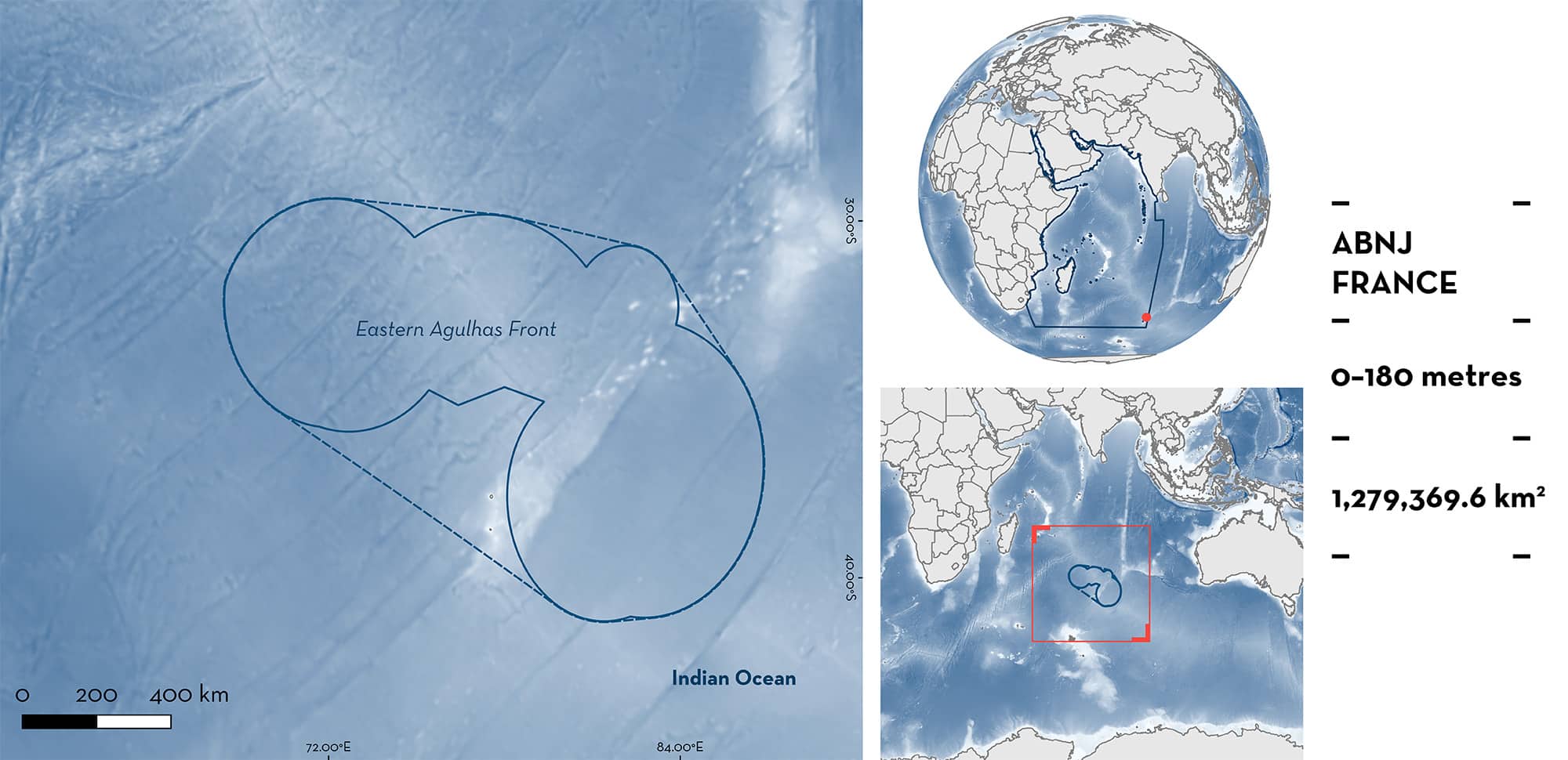ISRA FACTSHEETS
ISRA FACTSHEETS
WESTERN INDIAN OCEAN REGION
Eastern Agulhas Front
Summary
Eastern Agulhas Front is an offshore temperate pelagic area beyond national jurisdiction (ABNJ) in the central southern Indian Ocean. It overlaps with the Agulhas Front which is the eastward extension of the Agulhas Current. This area is characterised by unusually high productivity compared to other offshore areas of the Indian Ocean. The area overlaps with the Agulhas Front Ecologically or Biologically Significant Marine Area. Within this area there are threatened species and reproductive areas (Porbeagle Lamna nasus).
Download factsheet
Eastern Agulhas Front
DESCRIPTION OF HABITAT
Eastern Agulhas Front is an offshore temperate pelagic area in waters beyond national jurisdiction in the central southern Indian Ocean. The area is influenced by the eastward extension of the Agulhas Current, which connects water from southeastern Africa to subtropical and sub-Antarctic waters (Belkin & Gordon 1996; Kostianoy et al. 2004). The area is highly productive with levels of productivity not seen elsewhere in areas beyond national jurisdiction in the Indian Ocean. In the south, this area overlaps with the Subantarctic Front, which is colder with an annual mean sea surface temperature of ~6–13°C (Shukla et al. 2021). This area partially overlaps with the waters surrounding the islands of Saint-Paul and Amsterdam (France).
This Important Shark and Ray Area is pelagic and is delineated from surface waters (0 m) to 180 m based on the deepest area sampled and the most commonly used depths of the Qualifying Species during early life-stages.
CRITERION A
VULNERABILITY
The one Qualifying Species within the area is considered threatened with extinction according to the IUCN Red List of Threatened SpeciesTM. The Porbeagle is assessed as Vulnerable (Rigby et al. 2019).
CRITERION C
SUB-CRITERION C1 – REPRODUCTIVE AREAS
Eastern Agulhas Front is an important reproductive area for one shark species.
Commercial fisheries and survey data from pelagic longlines targeting mostly tuna in the Southern Ocean were examined. Between 1992–2011, 36,247 Porbeagles were captured with an effort of 212,622,118 hooks mostly from the Indian Ocean (Semba et al. 2013). Results indicated that most neonate and young-of-the-year (YOY) Porbeagles were in Eastern Agulhas Front compared to other areas across the Western Indian Ocean (Semba et al. 2013). Life-stage classification (i.e., < 1 year-old) was based on body size and reported growth curves (Francis et al. 2007). Size-at-birth is reported at 68–78 cm total TL and YOY individuals are usually < 102 cm TL (Ebert et al. 2021). Relative abundance was measured as standardized catch-per-unit-effort (CPUE; sharks/1,000 hooks). Eastern Agulhas Front had a CPUE for neonates and YOY of 0.5 compared to 0–0.1 in other areas of the Western Indian Ocean. Most neonates and YOY were recorded were captured at depths between 0–180 m from August to December; however, this was also the period with the highest fishing effort (Semba et al. 2013). This largely explains why few pregnant females were recorded.
Porbeagles generally segregate by temperature and latitude, with neonates and YOY in warmer waters than adults and juveniles (Yatsu 1995; Semba et al. 2013). In the Indian Ocean, the sea surface temperature (SST) at capture for neonates was significantly higher than those for juveniles and adults in every month analysed (Semba et al. 2013). In the South Pacific, the mean bodyweight of Porbeagles increases as the SST decreases (Yatsu 1995), supporting the results from the Indian Ocean.
It is likely that females migrate north to give birth in the area before August (low fishing effort) and return to cooler waters after parturition (Semba et al. 2013). Similar behaviour for this species has been also observed in the southwestern Pacific Ocean (Francis et al. 2015).
Download factsheet
SUBMIT A REQUEST
ISRA SPATIAL LAYER REQUEST
To make a request to download the ISRA Layer in either a GIS compatible Shapefile (.shp) or Google Earth compatible Keyhole Markup Language Zipped file (.kmz) please complete the following form. We will review your request and send the download details to you. We will endeavor to send you the requested files as soon as we can. However, please note that this is not an automated process, and before requests are responded to, they undergo internal review and authorization. As such, requests normally take 5–10 working days to process.
Should you have questions about the data or process, please do not hesitate to contact us.


